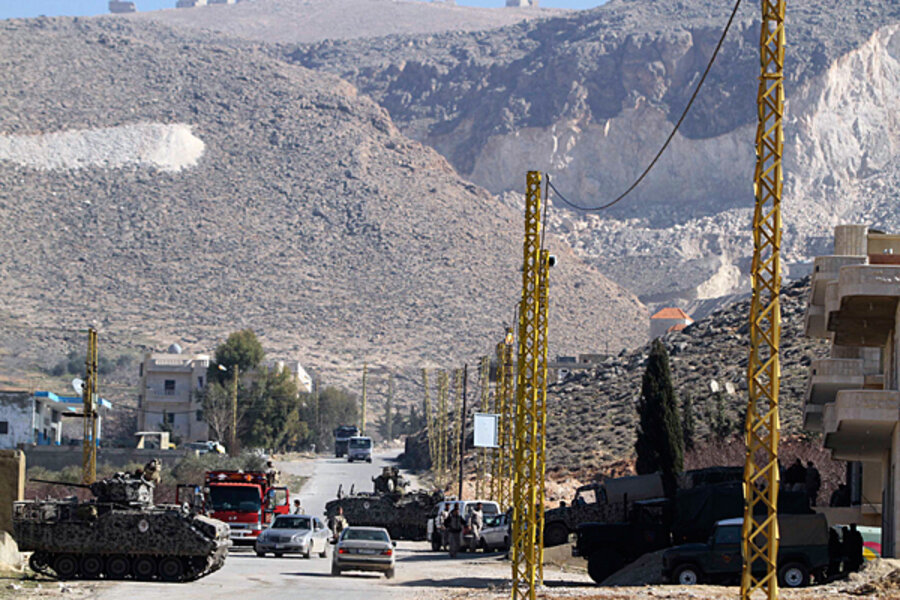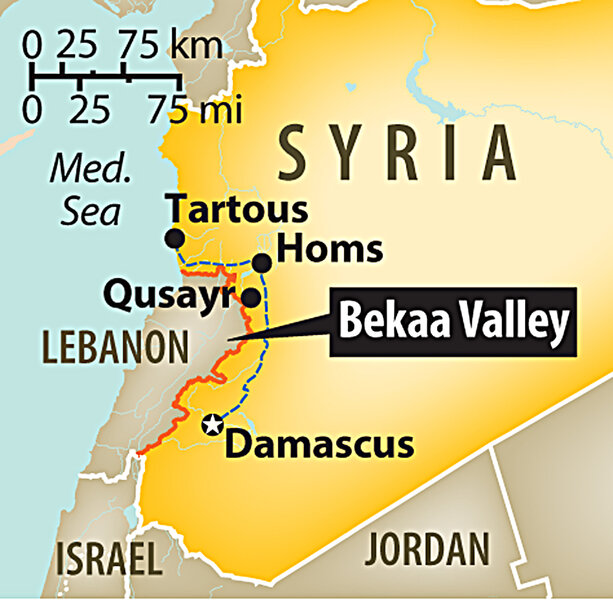Syrian regime battles rebels for control of highway to its safe haven
Loading...
| QASR, northern Bekaa Valley, Lebanon
An unremarkable area of flat fields, orchards, farms and small villages lying between the Syrian town of Qusayr and Lebanon’s northern border has become a fiercely contested battleground that threatens to expand into Lebanon.
Fighters from Lebanon’s Shiite militant group Hezbollah and Syrian Army troops are fighting the rebel Free Syrian Army for control of an area that could become strategically significant if Damascus falls to the rebels and the regime of President Bashar al-Assad is forced to flee. Qusayr lies close to the highway that connects Damascus to Homs, Syria's third largest city, and then to Tartous, the coastal town which is a gateway to the mountain chain dominated by Alawites, an obscure offshoot of Shiite Islam that forms the backbone of the Assad regime.
Some analysts believe that if Assad is forced out of Damascus, the rump regime will decamp to the Alawite mountains to form an enclave that could survive on the logistical and material support of Iran, a key ally of the Assad regime and patron of Hezbollah.
“If Assad gets driven out of Damascus… Qusayr will be very important as it links Damascus with the Alawite mountain. The highway will be crucial,” says Joshua Landis, professor of Middle East history at the University of Oklahoma and author of the influential Syria Comment blog.
The Qusayr pocket is a microcosm of Syria’s tangled sectarian demographics, where Lebanese and Syrian Sunnis and Shiites live beside Syrian Christians and Alawites. Some 23 villages and 12 farms west of Qusayr are inhabited by Lebanese Shiites, even though the area lies inside Syria. Border restrictions here are historically lax and there are numerous trails, tracks, and small paved roads used by smugglers and residents alike to move across the frontier.
Qusayr lies in the hands of the Syrian opposition, while those villages to the west populated by Lebanese Shiites remain loyal to the Assad regime, a staunch ally of Hezbollah. The fight for control of this area has become fierce.
Syrian rebels accuse Hezbollah of assisting government troops in attacking Sunni villages in the area. Hezbollah chief Sheikh Hassan Nasrallah admitted in October that some members of the party were fighting in Syria, but said they were defending Shiite villages from the armed Syrian opposition.
Hezbollah publicly continues to play down its role in Syria although it has become common knowledge that the group's fighters are deployed in several areas of the country, mainly across from Lebanon's northern and eastern borders and in Damascus.
A critical corridor
Some analysts suspect that the Shiite villages to the west of Qusayr could eventually form part of a corridor linking Hezbollah-controlled areas of Lebanon's northern Bekaa Valley to the southern edge of an Alawite enclave that could stretch up the coastal mountain chain to the port town of Latakia. If such a corridor were secured, it would have significant strategic consequences. It would allow Hezbollah to help the remnants of the Assad regime defend the enclave from attacks by Sunni groups. It could also become a new conduit for the flow of arms to Hezbollah.
Traditionally, the bulk of Hezbollah's weapons are smuggled into Lebanon from Syria. The fall of the Assad regime, however, would complicate Hezbollah's ability to bring in arms and, more critically, restock its arsenal in the aftermath of a future war with Israel. The theoretical Alawite enclave would have access to the sea through the ports of Tartous, Banias and Latakia, allowing for the potential import of weapons which could then be trucked to Hezbollah in Lebanon via the secured corridor.
"The Qusayr area is the nexus of the [Shiite-populated northern] Bekaa and the Alawite-dominated coastal mountains. It's key to keeping the regime-dominated [Alawite enclave] and [Hezbollah]-allied areas together," says Andrew Tabler, a Syria expert at the Washington Institute for Near East Policy. He added that the only useful purpose of an Alawite enclave for Iran is if it was attached to the Hezbollah area of the northern Bekaa Valley.
Still, establishing such a link between an Alawite enclave and Hezbollah areas of Lebanon would be a formidable and ambitious undertaking. It would mean the rump Assad regime would have to subdue or expel a large Sunni population, especially in the coastal cities and in some villages close to the Lebanese border. And the part of the enclave running along the western half of Lebanon's border would abut territory home to a hostile Lebanese Sunni population, parts of which already are a de facto safe haven for the FSA.
"The Alawites and the Syrian army will have to make some tough choices if they get pushed from Damascus," says Landis. "Ethnic cleansing [of Sunnis] in strategic areas will come on the agenda."
Tabler agrees, saying that the "corridor" linking the Bekaa Valley with an Alawite enclave would have to be established first, "then squeeze the Sunni areas".
The success of such an enclave would depend heavily on whether or not the Syrian opposition can unite to manage a smooth transfer to a new administration that can launch a process of reconciliation and reconstruction.
Most analysts predict a prolonged period of instability after Assad's fall, given the weakness and fractiousness of the civilian political opposition and the rivalries between the armed rebel groups, all of which will help sustain a potential Alawite enclave.
Qusayr heats up
Last week, the Qusayr pocket saw a surge in fighting as both sides appear to recognize the strategic value of the area.
Sources close to Hezbollah said that the fighting began when a checkpoint manned by about 12 members of Hezbollah near the Shiite village of Zeita, one mile north of the Lebanese border, came under attack by a large number of FSA fighters. The Hezbollah men repulsed the attack, but three fighters were killed and several others wounded.
Meanwhile, the FSA has accused Hezbollah of firing Katyusha rockets from Hawsh Sayyed Ali, a small farming hamlet on the border. Most maps mark Hawsh Sayyed Ali as lying just inside Syria, although it can be reached unimpeded from the Lebanese side, illustrating the vagueness of a border that has never been properly demarcated.
Yesterday Gen. Selim Idriss, the FSA's chief of staff, launched a scathing verbal attack on Sheikh Nasrallah, describing him as a “criminal."
"The killer does not belong to a religion, sect or nationality, and any killer will be killed eventually," Idriss said, according to a statement issued by the FSA's Joint Command.
His comments came shortly after the expiration of a 48-hour ultimatum delivered by the FSA in which it warned Hezbollah that it would launch attacks on their positions in Lebanon unless the Shiite party stopped fighting rebel forces in Syria. After the deadline passed yesterday morning, the head of the FSA's Farouq Brigade, Taleb al-Dayekh, claimed to have launched "mortar attacks against a number of Hezbollah locations in Lebanon's Hawsh Sayyed Ali region."
However, the Monitor was touring the border beside Hawsh Sayyed Ali at the time of the claimed attack and saw and heard no shelling. Local residents also denied having come under attack.
"There were a couple of explosions near Qusayr [five miles north of the border] around noon, but there's been nothing here," says Abu Ali, a businessman whose home lies on the southern bank of the Orontes river opposite Hawsh Sayyed Ali. "If the Israelis cannot find Hezbollah positions in Lebanon how are the Free Syrian Army going to find them?" he scoffed.
The FSA later released a statement saying that it had targeted Hezbollah positions west of Qusayr, possibly the origin of the two explosions Abu Ali heard at noon.
Digging in
Indeed, after several days of fighting, the border area was quiet today. Qusayr was visible through the haze, a slash of white buildings in a fertile dark green landscape of fields and orchards. But few believe that the lull will last.
"There is shelling every night along the border. Sometimes it is so heavy and so close it feels like my house is dancing," Abu Ali says.
Hezbollah vehicles – usually SUVs with tinted windows and no license plates – bounced along the potholed lanes beside the border. One pickup truck with a canvas awning covering the back (a type of vehicle used by Hezbollah to transport recruits to training camps in the rugged mountains flanking the Bekaa Valley) raced down the road from the border crossing at Hawsh Sayyed Ali. Three men in camouflage uniforms and one of them wearing a helmet were crammed into the front seats.
Although the FSA's promise to fire on Hezbollah inside Lebanon has yet to be fulfilled, the Lebanese side of the border has been struck several times in the past days and weeks. Abu Ali indicated a pair of pock marks on the side of the road a few hundred yards from his house which he said were caused by exploding mortar rounds. A few nights ago, the small Shiite-populated town of Qasr on the border was struck by two 107mm rockets.
"No one was hurt, thank God, but it was the first time they have attacked us here in Qasr," says Rakkan Jaffar, the town's mayor. Mr Jaffar, who was working in his stone-cutting factory just 200 yards from an earth berm that marked the border, blamed the fighting on rebels who were either foreigners or from other areas of Syria.
"We have an agreement with the Sunnis in the [Qusayr] area that we will not fight each other. We live with them here and they are our brothers. But outsiders have come here, including Salafi jihadis, and they are stirring up problems between the people," he says.
Local Shiite residents, all of them Hezbollah supporters, insist that the party's fighters are simply defending the Lebanese Shiite villages. But FSA rebels are equally adamant that Hezbollah is on the offensive and have deployed into several Sunni and Christian villages east of the Lebanese Shiite villages.
"Hezbollah is all along the border now and they are helping the Syrian army," says Ahmad, a young Syrian FSA member from Qusayr who was resting for a few days in a Lebanese village near the border. He says that 5,000 members of the Farouq Brigade, one of the largest and most powerful FSA groups, have deployed into the Qusayr area to help crush Syrian regime forces, adding that they were concentrating their efforts on a military base south of Qusayr.
"The base supplies other army positions around Qusayr. Once we have taken the base, Hezbollah will be easier to deal with," he says. "Then we will move into the Shiite villages [west of Qusayr] to remove Hezbollah. They are causing us too many problems."








